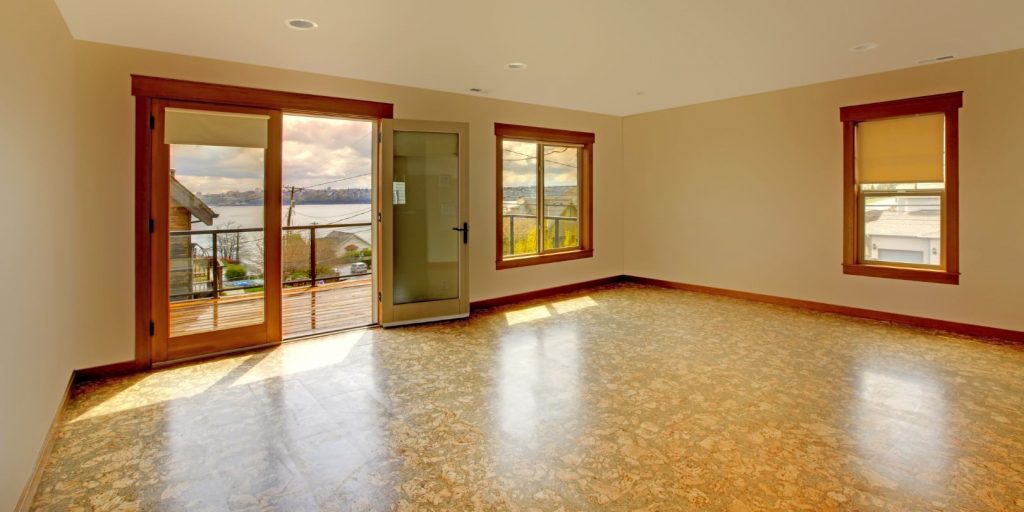Cork Flooring: Types, Pros and Cons, and Installation Tips

Thinking of a unique flooring for your next home project? Cork flooring emerges as a top choice for those seeking eco-friendly and adaptable flooring solutions. Celebrated for its distinctive qualities, cork marries aesthetics with functionality. Within this extensive guide, we will explore the properties of cork flooring, dissecting its diverse types, weighing the advantages and disadvantages of this option, and offering crucial installation insights. Whether you’re in the midst of a home renovation or striving to embrace environmentally conscious design, cork presents itself as a compelling solution that seamlessly blends style, sustainability, and comfort into your living space.
Types of Cork Flooring
Cork Tiles
Cork tiles are a popular choice for those who prefer a traditional and versatile flooring option. These tiles are available in various sizes and can be installed using adhesive. You can create unique patterns and designs by mixing different tile colors or sizes.
Cork Planks
Cork planks mimic the look of hardwood flooring and are an excellent option for achieving a classic and timeless appearance. They come in different lengths and widths, providing flexibility in design. Cork planks often feature a click-and-lock installation system for ease of use.
Floating Cork Floors
Floating cork floors are an engineered cork flooring option. They consist of cork layers bonded to a high-density fiberboard (HDF) or plywood core. These floors are designed to “float” over the subfloor, thanks to a click-and-lock or tongue-and-groove system. Floating cork floors are easy to install and offer excellent insulation and comfort underfoot.
Glue-Down Cork Floors
Glue-down cork flooring involves adhering cork tiles or planks directly to the subfloor using adhesive. This method ensures a secure and stable installation. It’s important to follow manufacturer guidelines for adhesive application to achieve optimal results.
Pros of Cork Flooring
Sustainability
Cork is a renewable resource harvested from cork oak trees without harming the tree itself. The bark naturally regenerates, making cork one of the most sustainable flooring materials available. Choosing cork supports eco-conscious practices.
Comfort and Insulation
Cork’s unique cellular structure provides natural insulation, making it comfortable to walk on and helping to maintain a consistent room temperature. It also reduces sound transmission, making it an excellent choice for bedrooms or playrooms. Walking on cork feels soft and warm, enhancing your overall comfort.
Durability
Cork is resilient and can withstand daily wear and tear. It’s resistant to cracking and abrasions, making it suitable for high-traffic areas. Its durability means you can enjoy your cork flooring for many years.
Allergen Resistance
Cork is naturally resistant to mold, mildew, and common allergens. It creates a healthier indoor environment for allergy sufferers. This feature ensures your home remains allergen-free and safe.
Aesthetic Appeal
Cork comes in a variety of colors and patterns, allowing you to achieve a customized look that complements your interior design. Its versatility in appearance enables you to match it with any decorating style, from traditional to modern.
Cons of Cork Flooring
Susceptibility to Moisture
Cork is sensitive to moisture and can swell or warp when exposed to excessive humidity or water. It’s not the best choice for bathrooms or areas prone to water spills. Ensuring a dry environment is crucial to prevent damage.
Vulnerability to Indentations
Heavy furniture or sharp objects may cause permanent indentations or damage to cork flooring. Furniture pads and proper care can help mitigate this issue. Taking precautions protects your cork flooring from unnecessary wear.
Maintenance Requirements
Cork flooring requires regular sealing to protect it from stains and moisture. Failing to maintain the seal can lead to damage over time. Proper maintenance ensures your cork floor retains its beauty and durability.
Initial Cost
While cork offers long-term value, it may have a higher upfront cost compared to some other flooring options. Consider the long-term benefits and energy savings to make it an investment that pays off.
Installation Tips
For a successful cork flooring installation, it’s crucial to follow these key tips. First, ensure your subfloor is impeccably prepared. It should be clean, level, and completely dry to facilitate a seamless installation. Give the cork flooring time to acclimate to the room’s temperature and humidity for a minimum of 48 hours before laying it down to prevent issues like warping. In moisture-prone areas, incorporate a moisture barrier beneath the cork flooring to safeguard its durability. Strictly adhere to the manufacturer’s installation guidelines, encompassing recommendations for adhesive, underlayment, and sealing products, to guarantee a successful installation. For intricate or sizable installations, contemplate the expertise of a professional installer experienced in cork flooring, equipped with specialized tools like miter saws to ensure a flawless outcome.
Conclusion
In conclusion, cork flooring offers a sustainable, comfortable, and visually appealing option for homeowners. By understanding some of the factors in this article, you can make an informed decision about whether cork is the right choice for your home. Embrace the beauty and eco-friendliness of cork flooring while enjoying its many benefits in your living space. Whether it’s the comfort, sustainability, or aesthetic appeal, cork flooring offers a well-rounded flooring solution for your home.
